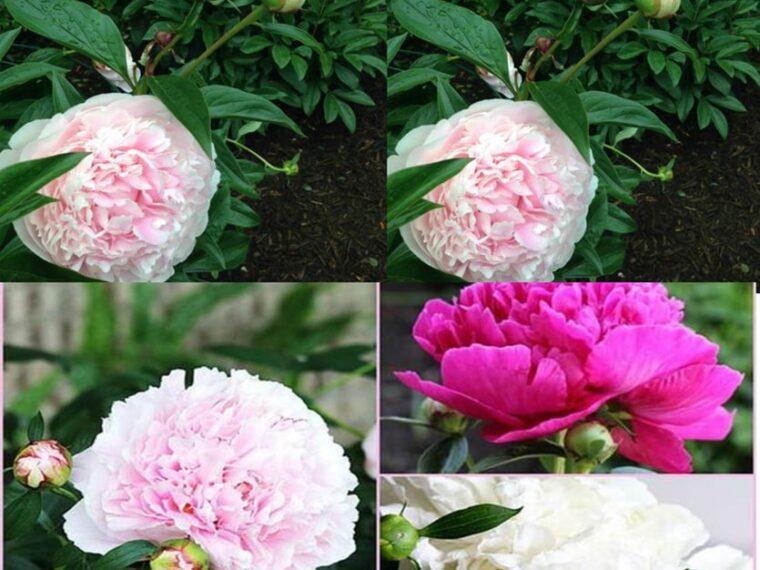6. Caring for Peonies Through the Seasons
Watering
- Water deeply once a week during the growing season, especially in dry weather.
Fertilizing
- Use a balanced fertilizer (e.g., 10-10-10) in early spring and after flowering. Avoid over-fertilizing, as this can reduce blooms.
Mulching
- Apply a 2–3 inch layer of mulch in spring to retain moisture and suppress weeds.
7. Supporting Peony Blooms
Large peony blooms can become heavy and droop. To prevent this:
- Install peony rings or stakes early in the growing season.
- Position supports carefully to avoid damaging the roots.
8. Pruning and Deadheading Peonies
- Deadheading: Remove spent blooms to encourage more flowers and maintain plant health.
- Pruning: In late fall, cut herbaceous peonies down to ground level. For tree peonies, remove only dead or damaged wood.
9. Preventing Pests and Diseases
Common Pests
- Aphids: Spray with insecticidal soap.
- Ants: While they are attracted to peony nectar, they don’t harm the plant.
Common Diseases
- Botrytis Blight: Prevent with good air circulation and by avoiding overhead watering.
- Powdery Mildew: Treat with fungicides or neem oil.
10. How to Divide and Propagate Peonies
- Divide peonies every 10–15 years to rejuvenate the plant and encourage more blooms.
- Best time to divide is in early fall.
- Use a sharp knife to separate root sections, ensuring each has at least 3–5 eyes.
11. Growing Peonies in Containers
- Choose a container at least 18 inches deep and wide.
- Use well-draining potting soil enriched with compost.
- Water regularly, ensuring the container doesn’t dry out completely.
12. Companion Plants for Peonies
Pair peonies with plants that complement their blooms and growth habits, such as:
- Salvias: Add height and contrasting color.
- Irises: Provide early-season interest before peonies bloom.
- Hostas: Offer foliage contrast in shaded areas.
13. Common Challenges and Solutions
- No Blooms: Likely due to planting too deeply or insufficient sunlight.
- Yellowing Leaves: May indicate waterlogged soil or nutrient deficiencies.
- Short Bloom Time: Plant multiple varieties to stagger flowering periods.
14. Seasonal Care Calendar for Peonies
- Spring: Fertilize, support growth, and monitor for pests.
- Summer: Water regularly and deadhead blooms.
- Fall: Prune and divide plants as needed.
- Winter: Mulch for protection in colder climates.
15. Benefits of Growing Peonies at Home
- Enjoy vibrant blooms that return year after year.
- Attract pollinators like bees and butterflies.
- Enhance the aesthetic appeal of your garden.
Conclusion
Cultivating peonies is an art that rewards gardeners with stunning blooms and timeless beauty. By choosing the right location, preparing the soil, and providing consistent care, you can enjoy these romantic flowers for decades. Whether you plant them in the garden or containers, peonies are a testament to nature’s elegance and resilience.
FAQs
1. How long do peonies take to bloom after planting?
Peonies typically take 2–3 years to produce their first significant blooms.
2. Can I grow peonies in hot climates?
Yes, but provide some afternoon shade and keep the soil moist during hot summers.
3. Do peonies need to be replanted every year?
No, peonies are perennials and can thrive in the same spot for decades.
4. Can I grow peonies indoors?
Peonies are best suited for outdoor cultivation due to their sunlight needs.
5. Why are ants attracted to my peonies?
Ants are drawn to the nectar on peony buds. They don’t harm the plant and can help keep other pests away.




